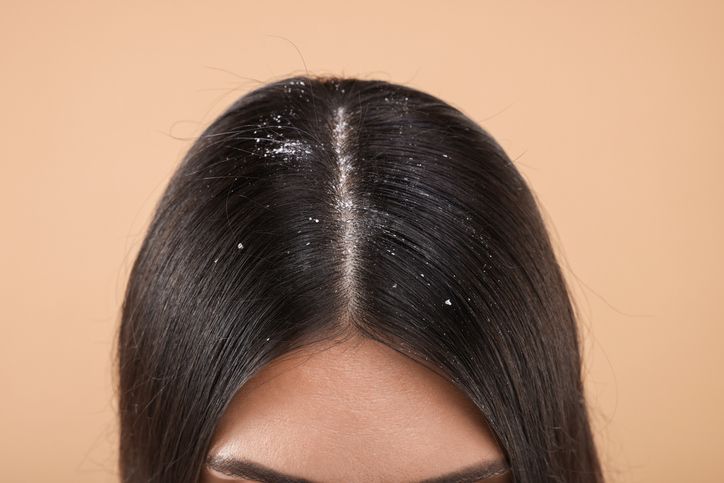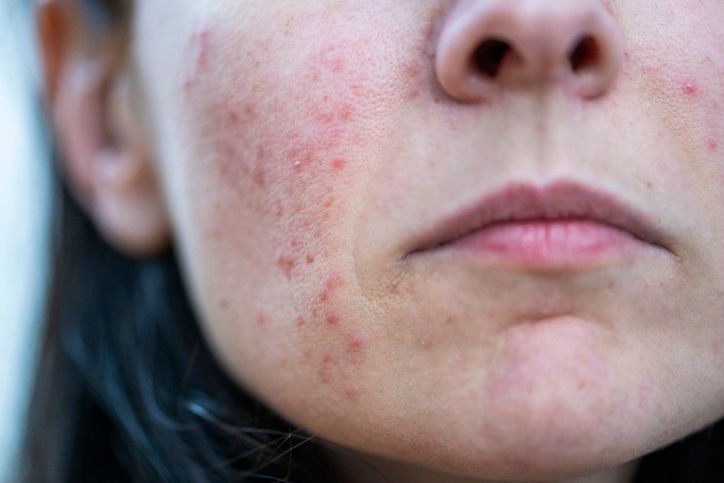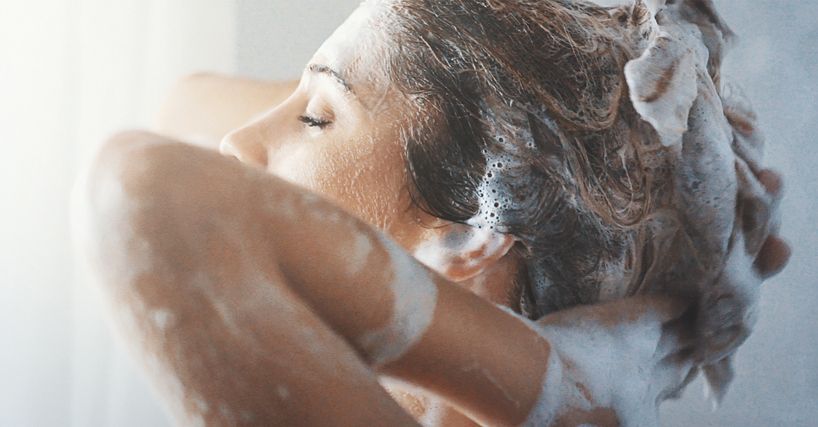
Author: Natalie Ng|Updated: 18 June 2025
If your scalp’s been itchy or flaky lately, you might be wondering whether it’s dandruff or just buildup from hair products. They can look alike, but they come from different things. Dandruff is usually tied to skin conditions like seborrheic dermatitis or scalp psoriasis, while buildup is more about leftover product, natural oils, and dead skin that hasn’t been washed away properly. The flakes might seem similar, but they don’t behave the same. Dandruff tends to stick around even after washing, while buildup usually rinses off—at least for a while. Where it shows up can also give you a clue. Dandruff often starts at the top of the scalp, but buildup shows up more around the hairline or near the ears. If you’re trying to figure out what’s really going on with your scalp, knowing these small differences can help you treat the issue more effectively. Keep reading to learn how to spot the signs and get your scalp back to a healthier place.

Examine the Color and Texture of Flakes

Color and texture differences between scalp buildup and dandruff
Dandruff flakes are usually small, round, and soft. They’re white or gray and tend to feel light—like bits of tissue. These flakes often stick together due to oil and may come with itching or signs of scalp inflammation. If you have seborrheic dermatitis, oily skin, or scalp psoriasis, these flakes might be more frequent and harder to get rid of.
What scalp buildup flakes look and feel like
Scalp buildup flakes look different. They’re larger, waxy, and often yellowish. They can feel sticky or dense and may come off in soft clumps when you scratch your scalp.
This type of buildup forms when:
• Dead skin cells and natural oils collect on the scalp
• Hair care products like hair gels or moisturizing conditioners aren’t rinsed out properly
• You don’t wash your hair regularly or use harsh shampoos that dry out the scalp
One way to tell the difference
You can test a flake in water:
• Dandruff flakes usually dissolve
• Buildup flakes stay intact

Watch How Your Scalp Reacts After Washing

Immediate changes after washing your hair
Right after washing, your scalp’s response gives you useful signs. If you’re dealing with product buildup, your scalp will usually feel clean and light right away. Flakes disappear, and your scalp looks clear. But with dandruff, things feel different. The itching may continue even after washing, and you might still notice flakes or irritation around the scalp.
How your scalp feels tells you a lot
• Buildup gives a quick sense of relief after shampooing
• Dandruff leaves the scalp feeling irritated or itchy, even when freshly washed
• Dandruff flakes may still show up right after washing, especially around irritated patches
Check your scalp in the mirror while your hair is damp. If it looks smooth and clean, it's likely buildup. If you still see redness or patchy flakes, dandruff may be the cause.
Signs that buildup is coming back fast
Pay close attention in the days after washing. Buildup usually returns within a few days, especially if you're using heavy hair products or skipping washes.
Common signs of returning buildup:
• Within 24 hours: scalp starts feeling waxy at the roots
• Day 2–3: flakes reappear as white or yellowish residue
• Around day 4: scalp may start feeling heavy or itchy again
This fast buildup cycle often points to leftover hair products or shampoos that aren’t removing dead skin cells and residue effectively. If you’re using moisturizing conditioner, hair gels, or dry shampoo regularly, buildup tends to come back quicker—unlike dandruff, which follows a different pattern.
Read More
Book Now to Experience
F8 Hair Regrowth Treatment
1 Minute Self-Registration
Date should not be before minimal date

Look for Signs of Scalp Inflammation
Inflammation points to dandruff, not buildup
If your scalp feels irritated or sore, it’s often a sign of dandruff—not product buildup. Dandruff is linked to skin conditions like seborrheic dermatitis and scalp psoriasis, both of which cause inflammation. That irritation shows up as redness, warmth, and increased sensitivity when you touch or brush your scalp.
What to check for on your scalp
In bright lighting or using a handheld mirror, examine your scalp closely. Watch for:
• Pink or red patches, especially near the crown or behind the ears
• Tenderness when you press on certain spots
• A warm or burning sensation, especially after using hair care products
• Itching that doesn’t go away even after washing
These signs often point to mild dandruff or a related skin condition. If certain products worsen dandruff or cause stinging, your scalp may be inflamed. On the other hand, scalp buildup doesn’t usually cause discomfort. It might feel greasy or heavy, but it doesn’t create hot or sore areas.
If touching parts of your scalp feels uncomfortable or if your skin reacts to shampoos or styling products, dandruff is more likely the cause than product build up.

Track Flare-Ups Across Different Seasons
Dandruff changes with the weather; buildup stays more regular
Scalp conditions don’t always behave the same throughout the year. If your flakes come and go with the seasons, it’s likely dandruff. Dandruff often flares up in colder months when dry skin is more common, especially due to indoor heating and harsh winter air. On the other hand, scalp buildup tends to stay steady unless your product use or washing habits change.
Seasonal patterns that suggest dandruff
• Winter: Flaky scalp and scalp inflammation often get worse
• Summer: Hot weather may increase oil production, but dandruff symptoms may improve
• Transitional months: Dandruff symptoms can spike when humidity or temperature shifts
Product buildup reacts more to your routine than seasons
If your flaking stays about the same all year and gets worse after using certain hair products or skipping washes, it's probably related to scalp buildup. Frequent styling, harsh chemicals, or heavy conditioners often play a bigger role in buildup than the time of year.
Book Now to Experience
F8 Hair Regrowth Treatment
1 Minute Self-Registration
Date should not be before minimal date

Review Your Hair Care Routine for Clues
Buildup often comes from product choices and washing habits
Your daily routine plays a big role in how your scalp behaves. The type of products you use and how often you wash your hair can help you figure out whether you’re dealing with dandruff or scalp buildup. Buildup usually happens when heavy products, dry shampoos, or styling gels aren’t rinsed out fully—or when you don’t wash your hair regularly.
If you’re seeing greasy roots, white patches, or a waxy texture near the scalp, product residue is likely building up. Dandruff, in contrast, isn’t caused by product use but by an underlying skin condition that causes skin cells to shed too quickly.
What product buildup might look like in your routine
• Shampoo: If your scalp feels coated or waxy after washing, your shampoo may not be strong enough to break down residue. Try switching to a clarifying shampoo to reduce scalp buildup.
• Conditioner: Applying conditioner too close to the roots can lead to greasy or heavy-feeling hair. Focus on applying it from mid-length to ends to avoid buildup near your scalp.
• Styling gel: If you notice flaking or stiffness after styling, your gel might be too heavy. Using a lighter formula can help prevent product build up.
• Hair spray: Regular use can leave white patches or dry flakes behind. Try reducing how often you use it, especially near the roots.
• Dry shampoo: A powdery or gritty texture left behind on your scalp is common with overuse. Alternate usage and wash your hair regularly to keep your scalp clean.
If your scalp feels coated, sticky, or heavy after using certain products, and the flakes come off in clumps rather than individually, you’re likely dealing with buildup. Try washing with a gentle shampoo more often and avoid layering too many hair care products.
When you notice your scalp feels clean, clear, and itch-free after switching products, it’s another sign dandruff is the cause.

Check Where Flakes Are Showing Up on Your Scalp
Flake location reveals the difference between buildup and dandruff
Where flakes appear on your scalp can help you figure out what you’re dealing with. Scalp buildup tends to concentrate in areas where hair products are applied most—usually the hairline, behind the ears, and the nape of the neck. Dandruff, on the other hand, usually shows up across your scalp in no clear pattern. It’s often scattered and more noticeable in areas with higher oil production, like the crown of the head.
What to look for in flake distribution
Scalp buildup is more localized
○ Often collects around the edges of your scalp: hairline, ears, and back of the neck
○ Flakes feel waxy or sticky and can be gently rubbed off in soft layers
Dandruff is more spread out
○ Appears in random patches, especially around oilier areas of the scalp
○ Flakes are smaller, dry or oily, and fall off more easily
Spotting early signs in common areas
Take note of where flakes start. Buildup usually forms near styling points—where you apply hair gels, sprays, or conditioners. If flakes first appear at the part line or hairline and then spread downward, it likely points to product residue. Dandruff usually starts near the center of your scalp and spreads outward, often returning to the same spots even after you wash your hair.
If flaking always comes back in isolated, consistent areas, even right after using a dandruff shampoo, there’s a good chance you’re seeing symptoms of a skin condition like seborrhoeic dermatitis or dry scalp, not just buildup from products.
Book Now to Experience
F8 Hair Regrowth Treatment
1 Minute Self-Registration
Date should not be before minimal date

Pay Attention to How Long Symptoms Last
Persistent flakes suggest dandruff, not just buildup
How long your symptoms last can reveal whether you’re dealing with scalp buildup or dandruff. Buildup tends to come and go quickly, especially depending on how often you wash your hair or which products you’re using. It usually disappears completely after a good wash and only returns when residue builds up again.
Dandruff tends to be more stubborn. Even with regular washing or switching shampoos, you might still notice dandruff flakes, scalp flaking, or discomfort. If your symptoms have been consistent for more than a few weeks—even after using a clarifying shampoo or changing your routine—it’s likely dandruff or a related skin condition like seborrheic dermatitis.
Differences in timeline and severity
• Scalp buildup symptoms come and go depending on your product use or washing habits
• Dandruff symptoms persist for weeks or longer and are less affected by your hair routine
• Dandruff-related itching tends to feel more intense and deep, while buildup discomfort feels more like surface-level heaviness or greasiness
If the problem doesn't improve after using a gentle shampoo, reducing hair products, or rinsing with lukewarm water, it's time to consider that you're dealing with more than just product build up. Longer-lasting symptoms may require a dandruff shampoo or a medicated shampoo with active ingredients like salicylic acid, selenium sulfide, or zinc pyrithione.

Common Habits That Can Worsen Scalp Conditions
Certain daily routines may be making your scalp issues worse. Even small things like using hot water or skipping wash days can lead to more flakes, itching, and irritation. Whether you’re dealing with mild dandruff or regular scalp buildup, it helps to take a closer look at how you treat your scalp.
Habits that can worsen dandruff
• Using hot water: Hot water can strip your scalp’s natural oils, leading to dryness and flaking. Stick to lukewarm water when washing your hair.
• Overwashing or using harsh shampoos: Washing too often with strong cleansers can irritate the scalp and make dandruff worse. Use a gentle shampoo that doesn’t contain harsh chemicals.
• Not treating inflammation: Ignoring redness, itching, or sensitivity can cause symptoms to spread. If you suspect scalp inflammation or a skin condition, treat it early with a medicated shampoo or dandruff treatment.
• Stopping treatment too soon: Stopping use of an effective dandruff shampoo as soon as flakes clear can cause flare ups to return. Stick with your treatment plan for at least a few weeks.
Habits that can increase product buildup
• Applying products too close to the scalp: Styling products, oils, and conditioners should be kept away from the roots when possible.
• Not rinsing thoroughly: Residue from hair gels, sprays, or even moisturizing conditioner can build up if not washed out properly.
• Using too many products at once: Layering leave-ins, oils, and sprays can create buildup quickly, especially on oily hair.
• Skipping regular washing: Washing your hair regularly is one of the best ways to reduce scalp buildup, especially if you use styling products often.
Book Now to Experience
F8 Hair Regrowth Treatment
1 Minute Self-Registration
Date should not be before minimal date

Best Ways to Treat Scalp Buildup vs Dandruff
Treatment options depend on the cause
Treating scalp buildup and dandruff isn’t the same. They need different approaches, products, and habits. If you treat dandruff like buildup—or buildup like dandruff—you probably won’t see much improvement. Identifying the right solution starts with knowing what’s behind your symptoms.
How to treat scalp buildup
Buildup happens when products, natural oils, and dead skin cells collect on your scalp. To reduce scalp buildup, your goal is to remove excess residue and prevent new layers from forming.
Effective ways to treat scalp buildup:
• Use a clarifying shampoo once a week: This helps dissolve product residue and wash away dead skin flakes. Avoid using it too often, as it can dry out your scalp.
• Wash your hair regularly: Keeping your hair clean prevents buildup from collecting, especially if you use hair gels or moisturizing conditioner.
• Rinse with lukewarm water: Hot water can leave your scalp dry and worsen residue.
• Avoid layering heavy hair products: Use lighter styling formulas and apply conditioner only from mid-length to ends.
• Exfoliate the scalp gently: You can use a scalp scrub or soft brush to loosen buildup without irritating hair follicles.
How to treat dandruff
Dandruff is usually caused by a skin condition such as seborrheic dermatitis, dry scalp, or scalp psoriasis. To treat dandruff, you’ll need to manage scalp inflammation, reduce flaking, and control symptoms over time.
Effective ways to treat dandruff:
• Use a medicated shampoo regularly: Look for active ingredients like salicylic acid, zinc pyrithione, selenium sulfide, coal tar, or ketoconazole.
• Stick to a treatment plan: Don't stop once flakes disappear. Continue using the dandruff shampoo as directed to prevent flare ups.
• Switch shampoos if needed: Some people respond better to different shampoos. Rotating between two formulas may improve results.
• Avoid harsh hair products: These can irritate sensitive areas and worsen dandruff symptoms.
• Moisturize if your scalp is dry: Use a gentle conditioner that soothes the skin without clogging pores.

How F8 Hair Regrowth Treatment Supports a Healthier Scalp
Even with the right shampoo or treatment plan, some scalp issues need more targeted support—especially when hair follicles are weak or blocked by buildup. This is where F8 Hair Regrowth Treatment can offer an added benefit. Designed to support both hair and scalp health, it works alongside your routine to improve scalp conditions and encourage healthy hair growth.
Why F8 treatment helps with scalp buildup and dandruff
If you’re dealing with scalp buildup, F8 helps by deeply cleansing and clearing clogged pores using a hair growth serum and low-energy laser technology. This reduces excess sebum and dead skin cells that often lead to scalp flaking and product build up. For those managing dandruff symptoms like scalp inflammation or dry flakes, the treatment calms the skin and improves blood flow to reduce irritation over time.
F8 doesn’t replace your usual dandruff shampoo or clarifying routine—but it enhances the results by helping your scalp stay balanced and better absorb nutrients.
How F8 Hair Regrowth Treatment works
The treatment includes three main steps:
• Scalp analysis: A hair specialist examines your scalp under magnification to assess the severity of buildup or dandruff and check the health of your hair follicles.
• Laser stimulation: A non-invasive low-energy laser is applied to the scalp. This helps stimulate inactive hair follicles, boost circulation, and strengthen the capillaries that carry nutrients to your scalp.
• Hair serum infusion: A targeted serum is applied to cleanse the scalp, remove residue, and hydrate the skin. This supports a better oil-water balance and improves overall scalp condition, especially in areas affected by oil, itching, or white flakes.
Key advantages of F8 for scalp health
• Reduces scalp buildup by unclogging follicles and removing dead skin flakes
• Improves blood flow to support healthier, more active hair follicles
• Relieves symptoms tied to dry scalp and oily skin
• Supports long-term scalp maintenance, especially for those with recurring flare ups
• No downtime — safe for both women and men, with no irritation or recovery needed
If you’ve been trying to treat dandruff or reduce scalp buildup but still notice recurring symptoms, F8 Hair Regrowth Treatment offers a gentle and effective way to support your scalp’s condition from the root. Regular sessions can make your hair feel fuller while helping to keep your scalp clean, clear, and balanced.
Book F8 today to restore scalp health and support stronger, healthier hair.
New Beauty's F8 Hair Regrowth TreatmentBook Now to Experience
F8 Hair Regrowth Treatment
1 Minute Self-Registration
Date should not be before minimal date
FAQ
Can poor hygiene cause both dandruff and scalp buildup?
Yes, poor hygiene can contribute to both. Not washing your hair regularly allows natural oils, dead skin cells, and sweat to collect on your scalp, creating an ideal environment for scalp buildup. At the same time, lack of washing may also worsen mild dandruff by allowing fungi or excess sebum to trigger scalp inflammation. Maintaining scalp hygiene by washing your hair gently and regularly helps prevent both conditions from worsening.
Is it possible to have both scalp buildup and dandruff at the same time?
It’s very common to have both. Scalp buildup from harsh hair products or styling residue can block follicles and trap dead skin flakes, making it harder for dandruff treatments to work properly. In some cases, product buildup can even worsen dandruff by irritating already sensitive areas of the scalp. If you suspect both, try reducing scalp buildup first with a clarifying shampoo before continuing your dandruff treatment plan.
What’s the difference between dry scalp and dandruff?
A dry scalp is caused by lack of moisture and usually results in small, dry flakes and mild itching. Dandruff, on the other hand, is linked to oily skin and overgrowth of yeast on the scalp, often causing larger, greasy white or yellow flakes. Dry flakes from dry scalp usually fall off easily, while dandruff flakes tend to stick and come with more noticeable scalp irritation. Using the wrong treatment—for example, moisturizing when the issue is oily skin—can worsen dandruff symptoms.
Can scalp buildup affect hair growth?
Yes, long-term scalp buildup can interfere with healthy hair growth. When buildup clogs hair follicles, it can prevent nutrients from reaching the roots, slow down new hair growth, and in some cases, contribute to thinning. This is especially true if buildup causes ongoing inflammation or restricts microcirculation in the scalp. Treatments that help reduce scalp buildup and increase blood flow—like F8 Hair Regrowth Treatment—can support healthier hair growth over time.
Are natural oils good or bad for dandruff?
Natural oils like coconut oil can help with a dry scalp by adding moisture and reducing minor flaking. However, applying oils to a scalp with seborrheic dermatitis or oily dandruff may make symptoms worse by feeding yeast growth and trapping dead skin flakes. If you’re dealing with dandruff, it’s important to first confirm the cause—dry skin vs oily scalp—before applying any oil-based product. For oily dandruff, it’s better to stick with medicated shampoo and avoid heavy oils.
Recommended Articles
COPYRIGHT© NEW BEAUTY MANAGEMENT LIMITED 2025. ALL RIGHT RESERVED.




